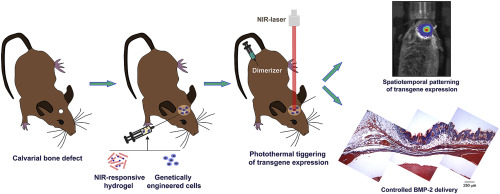Infrared sensitive hydrogels to control the regeneration of bone tissue.
NANBIOSIS U9 Synthesis of Nanoparticles Unit has participated in a research carried out bu researchers of CIBER-BBN group FIOBI-HULP at Hospital de la Paz, led by Nuria Vilaboa. reclently published in the scientific journal Biomaterials The researchers have used transgenic cells, which are incorporated into the scaffolding, to regulate the physiological production of bone growth factors and induce the osteoinduction process.
Achievement of spatiotemporal control of growth factors production remains a main goal in tissue engineering. In the present work, we combined inducible transgene expression and near infrared (NIR)-responsive hydrogels technologies to develop a therapeutic platform for bone regeneration. A heat-activated and dimerizer-dependent transgene expression system was incorporated into mesenchymal stem cells to conditionally control the production of bone morphogenetic protein 2 (BMP-2). Genetically engineered cells were entrapped in hydrogels based on fibrin and plasmonic gold nanoparticles that transduced incident energy of an NIR laser into heat. In the presence of dimerizer, photoinduced mild hyperthermia induced the release of bioactive BMP-2 from NIR-responsive cell constructs. A critical size bone defect, created in calvaria of immunocompetent mice, was filled with NIR-responsive hydrogels entrapping cells that expressed BMP-2 under the control of the heat-activated and dimerizer-dependent gene circuit. In animals that were treated with dimerizer, NIR irradiation of implants induced BMP-2 production in the bone lesion. Induction of NIR-responsive cell constructs conditionally expressing BMP-2 in bone defects resulted in the formation of new mineralized tissue, thus indicating the therapeutic potential of the technological platform.
Thanks to the participation of NANBIOSIS U9 Synthesis of Nanoparticles Unit it has been possible to explore the use of gold plasmonic nanoparticles, capable of absorbing light in the near-infrared (NIR) area and converting it into heat
Article of reference:
Sánchez-Casanova, S., Martin-Saavedra, F.M., Escudero-Duch, C., Falguera Uceda, M.I., Prieto, M., Arruebo, M., Acebo, P., Fabiilli, M.L., Franceschi, R.T., Vilaboa, N. Local delivery of bone morphogenetic protein-2 from near infrared-responsive hydrogels for bone tissue regeneration. Biomaterials 241:119909. https://doi.org/10.1016/j.biomaterials.2020.119909










